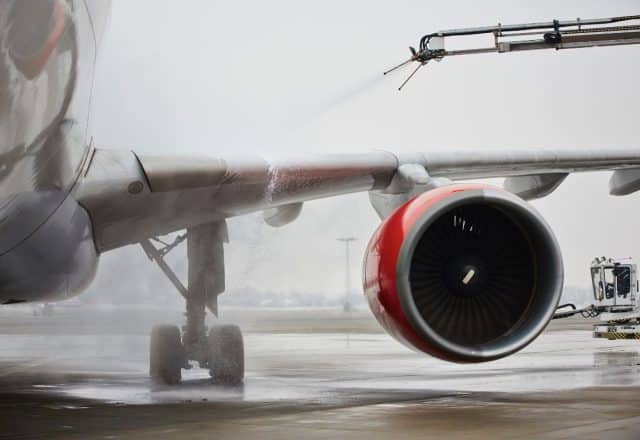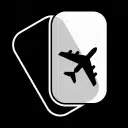Fly Higher This Winter: A Look at Private Jet De-icing
The sun glistens on the tarmac at Teterboro Airport. It’s a beautiful winter morning in New Jersey, and you and the family are getting ready to soak up the sun and ride the waves in Cabo San Lucas. But, before you can go wheels up in the Gulfstream GIVSP you chartered, the service crew hauls out the heavy equipment for your aircraft de-icing service.
A few minutes later, the crew is gone, and bright orange and green fluids cover your luxury jet. These fluids are the de-icing and anti-icing agents, and they’re used to help keep you safe and smooth in the air and are a common sight when chartering a private jet between November and March.
But what is private jet de-icing, and why is it important? Here’s an in-depth look at de-icing a private jet, how much it costs, and who pays for it.
What is de-icing?
Private jet de-icing is similar to removing snow and ice from your personal vehicle before going on the roads during the winter. However, unlike your car or truck, aircraft must be completely free of snow, ice, and frost before taking off.
The FAA’s clean aircraft concept requires the pilot-in-command to confirm that the aircraft is “clean” of all contaminants before the private jet is cleared for takeoff. That’s why the captain may call the crew in charge of private jet de-icing even if the sun is shining and the snow is melting.
Riding in trucks equipped with hydraulic lifts, pumps, and heaters, and carrying as much as 2,000 gallons of de-icing fluid, the aircraft de-icing service team sprays the private jet with de-icing fluid from the leading edges of the wings to the empennage, or the tail.
The orange fluid, also known as Type I, is mixed with water and heated to 180 degrees Fahrenheit to melt snow and ice. Meanwhile, the bright green fluid, called Type IV, is thicker and is used when it snows or rains to prevent these contaminants from sticking to the aircraft. De-icers typically use Type IV fluid before you board the plane, while you’ll often see crews de-icing a private jet with the orange fluid while you’re getting ready for takeoff.
Workers de-icing the wing of a plane at Austin Bergstrom Airport. pic.twitter.com/KDRRSM8bxe
— Shane Hinton (@MakeItRainShane) February 24, 2022
How much does it cost to de-ice a plane?
The cost for private jet de-icing varies greatly based on the type and amount of de-icing fluid required, the size of your aircraft, and the weather conditions. With prices typically above $20 per gallon, aircraft de-icing service costs can be as low as $1,500 for small turboprop planes to more than $10,000 for heavy jets.
Unlike commercial airliners, private jets are often stored in hangars. Choosing an aircraft stored in a hangar can reduce jet charter de-icing costs as the hangar keeps the plane safe from the elements.
Do airlines pay for de-icing?
With commercial airlines, passengers don’t need to worry about additional de-icing costs. However, when you charter a private jet, you may need to budget for de-icing if you’re flying during the winter charter season.
At Stratos Jets, our Soar and Soar Higher Private Jet Membership programs offer fixed-rate charters and cover the cost of aircraft de-icing services, so you always know how much you will have to pay.
How long can a plane sit after de-icing?
Your private jet is clear, and you’re ready for takeoff, but how long your plane can sit on the tarmac after de-icing depends on the weather and the type of fluid used.
The FAA publishes guidelines for each brand of approved de-icing and anti-icing fluid. The orange fluid, Type I, is only meant to remove contaminants before your flight. For longer holdovers, you’ll typically see aircraft de-icing service crews use the green fluid, or Type IV, which can grant holdover times as long as 160 minutes.

What happens if a plane doesn’t de-ice?
De-icing is an important step that helps your private jet fly smoothly and safely. Without de-icing a private jet, ice, snow, and frost can build up on the wings and tail of an aircraft. This build up reduces lift by changing the way the air flows over the wings. In severe conditions, ice buildup can also stall the aircraft’s engine.
How long does it take for a plane to get de-iced?
De-icing a private jet usually takes about 10 minutes, though it can take more than 30 minutes depending on the size of your private jet, the number of de-icing crews available, and the weather.
Why do planes not freeze at altitude?
For ice to form on planes, you need moisture and freezing temperatures. When a private jet reaches its cruising altitude in the stratosphere, the air is dry with little water vapor and no clouds, making ice less of a concern.
If cold weather and moisture are a concern during takeoff, the bright green anti-icing fluids provide a barrier until the jet reaches high altitudes. And, during your descent, your jet passes through cloud cover quickly as you make your safe landing at your destination.
Have questions about de-icing on your next jet charter or our fixed-rate Soar and Soar Higher Private Jet Memberships that also cover the cost of private jet de-icing? Our friendly and expert private flight advisors are here to answer your questions and make sure you enjoy a safe and comfortable journey through the skies. At Stratos, we only work with the most reputable operators, so you can rest assured that you’ll be flying safely and at the best available price. Request a free quote online or dial 888.593.9066 to get started today.
Are you ready to book your Miami to Aspen charter flight yet?
Our friendly, expert air charter agents are here to answer questions or start your quote today. Don`t wait, call now and we'll get you on your way to your destination!
Call 888-593-9066











